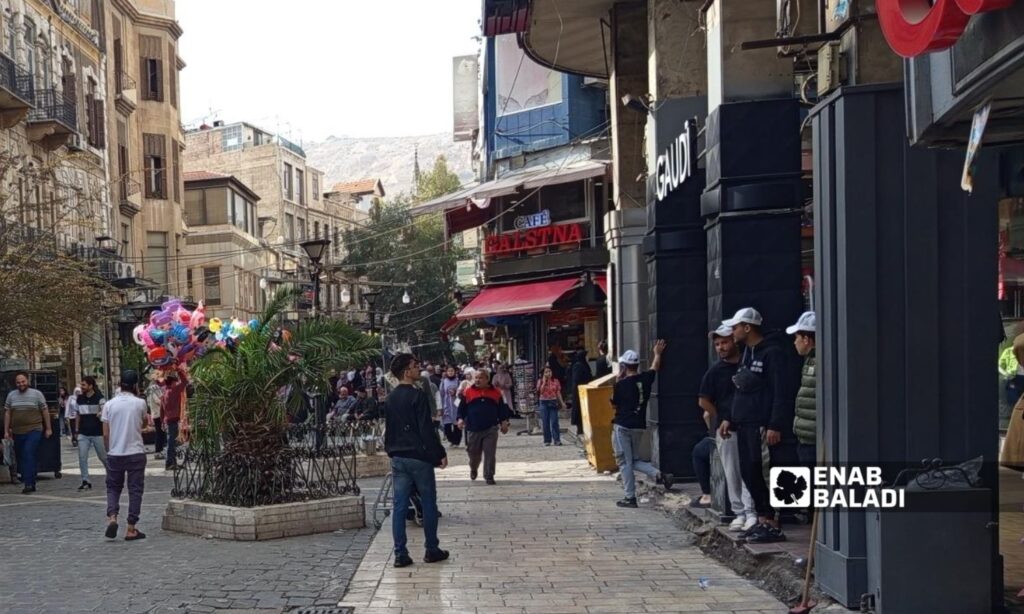The markets in Damascus are witnessing a rise in clothing prices coinciding with the approach of Eid al-Fitr, making the purchase of Eid clothes an additional burden amid the difficult economic conditions faced by Syrians.
The price increase is not limited to new clothes; it also includes used clothes (bale). This was expressed by a government employee, Maram al-Najjar, to Enab Baladi, saying, “The prices of used clothes are high like new clothes, and I will settle for buying the essentials for my children at the lowest cost.”
Focusing on the essentials
Al-Najjar stated to Enab Baladi that her financial capacity does not allow her to buy Eid clothes for her children, as prices are significantly high compared to her monthly income.
Mohsen al-Ali, a private sector employee, said to Enab Baladi that with three children, he is forced to choose between what they need and what he can afford, noting that Eid requires other things beyond clothing, such as sweets, among others.
Enab Baladi monitored clothing prices in the markets of Damascus, with children’s pants ranging from 60,000 to 85,000 Syrian pounds, sweaters priced between 50,000 and 100,000 Syrian pounds, and dresses costing between 85,000 and 200,000 Syrian pounds.
The price for women’s pants is between 150,000 and 250,000 Syrian pounds, while women’s sweaters range from 100,000 to 300,000 Syrian pounds. Dresses range between 400,000 and 550,000 Syrian pounds, and women’s jackets are priced between 300,000 and 450,000 Syrian pounds.
For men’s clothing, pants prices range from 150,000 to 300,000 Syrian pounds, shirts between 100,000 and 350,000 Syrian pounds, and sweaters from 100,000 to 300,000 Syrian pounds.
According to the official bulletin from the Central Bank of Syria (CBS), the exchange rate for the Syrian pound against the US dollar is 12,000 Syrian pounds, while in the black market, the rate is 10,450 Syrian pounds, according to the S-P Today website.
Mutaz al-Halabi, a shop owner selling clothes in al-Hamra market in Damascus, told Enab Baladi that the purchasing interest this year is somewhat acceptable, but most customers do not have the financial capacity to buy everything and are satisfied with purchasing necessities.
Despite lower costs
For his part, the Secretary of the Consumer Protection Association of Damascus, Abdul Razzaq Habzah, explained to Enab Baladi that clothing prices in markets during the Eid period or before it are an anomaly in commercial rules and are not subject to any economic law in the world. Despite the drop in the costs of raw materials like energy, transportation, and production, prices remain high and stable.
According to Habzah, manufacturers and traders are clinging to prices set in an illogical manner. For example, a family with four children would need at least 4 million Syrian pounds to buy good Eid garments for them.
As for the reasons behind the price increases in clothing, the Secretary of the Consumer Protection Association in Damascus pointed out that they result from traders sticking to their prices and profits. However, they should comply with the market, as there are imported garments of good quality that could be cheaper than domestic products.
Transitioning to the free market forces traders to compete, and given that taxes and customs have decreased from previous times, prices should decrease by about 40%. While traders do offer discounts, Habzah claims they are often misleading.
Regarding the purchasing interest, Habzah noted that while there are many shoppers in the markets, actual buying is weak due to low purchasing power on one hand and high prices on the other. Previously, the quality of domestic products was poor due to a lack of imports.
The Consumer Protection Association monitors prices in the markets, ensures that cost statements match the profit margins set by traders, and verifies that the advertised prices are consistent with the final ones.
The economic conditions faced by Syria cast shadows over all aspects of life, including Eid traditions that reflect family joy. Rising prices pose a challenge as families must control their budgets to meet the burdens of daily life.











